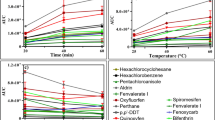Abstract
Two different extraction procedures to determine alachlor (2-chloro-2′,6′-diethyl-N-methoxymethyl-acetanilide) and its metabolites 2,6-diethylaniline (DEA) and 2-chloro-2′,6′-diethylacetanilide (CDEA) at very low concentration levels in groundwater are compared. Both methods were performed during a field leaching study and laboratory soil column experiments. Solid phase extraction (SPE) is characterized by the enrichment of 11 water samples at 1 g RP-C18 material, while micro liquid/liquid extraction (MLLE) means that 400 ml water samples saturated with sodium chloride were extracted once with 500 μl of toluene. Both methods differ in their concentration factors, i.e. 5000 for SPE and 800 for MLLE. The determination limits for alachlor determined as the lowest spiked concentration analyzed are 10 ng/l with SPE and 25 ng/l with MLLE. Even though the determination limits of the two methods are similar, the volatile metabolite 2,6-diethylaniline was not sufficiently recovered by SPE. Furthermore, SPE is more expensive and time consuming than MLLE. The latter is simple in use, rapidly performed and needs no evaporation step and clean-up before GC analysis. This is of special advantage for the analysis of 2,6-diethylaniline. The determination limits of the metabolites CDEA and DEA analyzed by MLLE are 25 ng/l. The extracts from both methods were directly analyzed by gas chromatography using electron capture and nitrogen-phosphorus detection.
Similar content being viewed by others
References
Heyer R, Stan HJ Intern J (1995) Environ Anal Chem (in press)
Junk GA, Richard JJ (1988) Anal Chem 60:451–455
Brooks MW, Jenkins J, Jimenez M, Quinn T, Clark JM (1989) Analyst 114:405–406
Schütte SA, Smith RG, Holden LR, Graham JA (1990) Anal Chim Acta 236:141–144
Murray DA (1979) J Chromatogr 177:135–140
Blanchet PF (1979) J Chromatogr 179:123–129
Thielen DR, Olsen G, Davis A (1987) J Chromatogr Sci 25:12–16
Pereira WE, Rostad CE, Leiker TJ (1990) Anal Chim Acta 228:69–75
Potter TL, Carpenter T, Putnam R, Reddy K, Clark JM (1991) J Agric Food Chem 39:2184–2187
EEC Drinking Water Guideline, 80/779/EEC, EEC No. L229/11–29, Brussels, August 30, 1980
Butz S, Heberer T, Stan HJ (1994) J Chromatogr 677:63–74
Deutsche Forschungsgemeinschaft (1991) Rückstandsanalytik von Pflanzenschutzmitteln 9. Lieferung. Kap. XI-A, XI-B. VCH Verlagsgesellschaft, Weinheim
Linkerhägner M, Thesis (unpublished results)
Zapf A, Heyer R, Stan HJ (1995) J Chromatogr (in press)
Heyer R, Stan HJ, in preparation
Author information
Authors and Affiliations
Rights and permissions
About this article
Cite this article
Heyer, R., Zapf, A. & Stan, H.J. Determination of alachlor and two metabolites in groundwater using solid phase and a new micro-liquid-liquid extraction method. Fresenius J Anal Chem 351, 752–757 (1995). https://doi.org/10.1007/BF00323631
Received:
Revised:
Accepted:
Issue Date:
DOI: https://doi.org/10.1007/BF00323631




